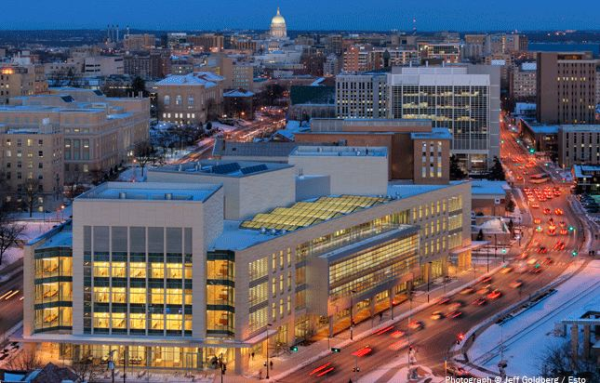The Laboratory of the Year represents the highest overall standards in both architecture and laboratory design, and generally illustrates push-the-envelope concepts in science buildings. --R&D Magazine
The Wisconsin Institutes for Discovery at the University of Wisconsin Madison has just won the award for 2012 Laboratory of the Year from R&D Magazine. The state-of-the-art facility spans 330,000 sf, including approximately 106,000 sf of research space, with wet and dry laboratories, research support areas, core facilities and offices. A model for public-private collaboration, the building houses and supports interaction between these two research entities (as well as the wider Madison life science community):
-
The public Wisconsin Institute for Discovery
-
The private, non-profit Morgridge Institute
What makes this facility award-worthy are all of the details of planning and construction, which means first and foremost the Institutes are situated at a natural crossroads between the northern and southern campus, then at a scientific crossroads between these neighoring Madison research buildings:
- College of Engineering
- Medical Sciences Center
- Genetics-Biotechnology Center
- Microbial Sciences building
In the four-storied Discovery Building, collaborative research projects are carried out across disciplines such as biology, information technology, and engineering. The research floors (Two through Four) are organized as laboratory "pods," each accommodating up to five PIs and their teams. Two pods per floor are designated as wet laboratory space, and a central pod is focused on dry, computational operations, which can be shared by the building's occupants. There is also a belowground floor that houses specialty laboratories requiring more complex utilities and high ceilings.
[The Wisconsin Institutes for Discovery collaborative research building, photo by Jeff Golberg/Esto, courtesy of UW-M]
The Morgridge and the Wisconsin Institute both have pods on each research floor to promote interactive discovery. The labs have a creative layer of insulation from outdoor traffic noise by being surrounded by an external atrium (or atria, more properly) rather than a central one. Then there are these design elements marking a reorientation of thinking about the collective, non-static business of research:
- Straight halls are non-existent; spaces are flexibly open to encourage interaction and accommodate collaboration.
- Common areas invite large and small group discussion and discovery.
- Communicating stairs are open and wider than utilitarian stairs, with room at the landings to pause for conversation or enjoy a view of the outdoors.
- Smart boards and flat screens are close at hand throughout.
- Labs were designed so they can be changed to match wet or dry research needs to provide flexible long-term use.
Naturally, the building is LEED-Gold certified. Additionally, this is the first research facility at UW–Madison constructed with a geothermal heating system.
Perhaps the most modern, envelope-pushing feature of the WID building is the design of the first floor as a Town Center, with civic spaces and gardens, meeting rooms, three public restaurants, and a business incubator. The public-private crossroads concept includes members of the public and neighboring UW researchers as well. Finally, since scientists are after all human, the space is very inviting, with the atria soaring upward to the roof, offering a glimpse into the lab floors on the way. There are even trees in the indoor space, illustrating that traditional limits really are, well, a thing of the past.
Biotechnology Calendar, Inc. will be on the U-W campus on September 5, 2012 to hold our 13th Annual BioResearch Product Faire event for the Madison life science community. We are a full-service event marketing and planning company producing on-campus, life science research trade shows nationwide for the past 19 years. We plan and promote each event to bring the best products and services to campuses across the country, ensuring that scientists have access to the latest tools and technologies available for their research labs. For information on exhibiting at the Madison show, click the button below:

See all of our upcoming shows in your area, and call to talk to one of our friendly, knowledgeable sales associates.


